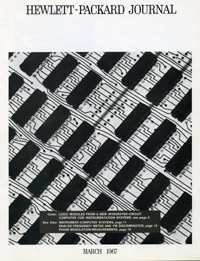Hewlett-Packard Journal March 1967

Article from Hewlett-Packard Journal March 1967 page 11.
Copy by permission of the Hewlett-Packard Company ™
Successful Instrument-Computer Marriages
Instrumentation computers are designed to be easy to incorporate into any system which contains electronic, chemical or medical instruments. Here are four remarkably varied examples of how these computers are being used.
Computing Data Acquisition System
 Data Acquisition Systems are the simplest type of instrumentation system. An elementary data acquisition system converts data from a number
of inputs to a form suitable for printing by an output recorder.
Data Acquisition Systems are the simplest type of instrumentation system. An elementary data acquisition system converts data from a number
of inputs to a form suitable for printing by an output recorder.
In more complex systems, some processing of the raw data is done, and the operation of the system may be controlled to some extent by the data. Because it can easily carry out complex programs, and because its programs can be changed easily, an instrumentation computer in a data acquisition system makes control of the system extremely flexible. It also provides rapid, local data processing, thereby eliminating the loss of time inherent in remote data processing.
A typical computing data acquisition system is shown in Fig. 1. Such systems are used, for example, in testing jet engines: the analog inputs are physical parameters such as pressure, temperature, fuel flow and engine speed, and the computer ouputs are operating parameters such as efficiency and power. The computer not only provides immediate results to help the operator set up the test, thereby making the checkout more automatic.
Fig. 2 is a block diagram of the system of Fig. 1, illustrating its use in jet engine testing. Surprisingly, this computing system costs little more than a less flexible noncomputing system capable of performing some, but not all, of the same tasks.

Gas Chromatograph System
 A Gas Chromatograph is a versatile chemical instrument which provides an analytical chemist with information about the composition of an unknown sample of material. However, it takes a considerable amount of interpretation and analysis to extract this information from the output of the chromatograph, and analytical chemists who do this type of work spend a large portion of their time on data reduction.
A Gas Chromatograph is a versatile chemical instrument which provides an analytical chemist with information about the composition of an unknown sample of material. However, it takes a considerable amount of interpretation and analysis to extract this information from the output of the chromatograph, and analytical chemists who do this type of work spend a large portion of their time on data reduction.
An instrumentation computer in a chromatograph system can not only free the chemist from time-consuming data reduction, but because it can analyze the outputs of many instruments,
it can also greatly increase the number of samples that a chemist can test in a day. Fig. 3 shows part of a developmental system in which an instrumentation computer will be used to analyze the outputs of up to 36 gas chromatographs.
Microwave Impedance-Measuring System
 A block diagram of an impedance-measuring system including an instrumentation computer and a network analyzer (Hewlett-Packard Journal, Feb. 1967) is shown in Fig. 4.
A block diagram of an impedance-measuring system including an instrumentation computer and a network analyzer (Hewlett-Packard Journal, Feb. 1967) is shown in Fig. 4.
This system measures the reflection coefficient of an unknown device as a function of frequency, then calculates impedance, admittance, standing wave ratio, return loss, and mismatch loss.
Residual errors in the system are measured with a calibrating short in place of the unknown, and the computer automatically substracts these errors from the measurements.
The refined results are stored in the computer memory and displayed on the oscilloscope. The network analyzer provides a Smith chart display of the raw data.
Logic Module Test System
 Final testing of a complex system (e.g., a computer) can be greatly simplified by pre-testing the modules or cards that make up the system. However, manual testing of logic modules can be extremely expensive and time consuming, because there are so many inputs and outputs to be checked.
A computer makes pre-testing practical, because it can automatically stimulate the modules and monitor their responses. A complete test of a module with 16 inputs would
Final testing of a complex system (e.g., a computer) can be greatly simplified by pre-testing the modules or cards that make up the system. However, manual testing of logic modules can be extremely expensive and time consuming, because there are so many inputs and outputs to be checked.
A computer makes pre-testing practical, because it can automatically stimulate the modules and monitor their responses. A complete test of a module with 16 inputs would
require 2 E16, or 64,000, different tests. At one minute per test, it would take a technician six months to test one module. An instrumentation computer can do it in less than one minute.
The computer can also keep statistics on the tests for quality control. Logic modules fo HP instrumentation computers are tested by the computer system illustrated in Fig. 5. The response of the module under test is compared with that of a reference circuit and the operator is alerted if the test device's response is not within specified limits.


